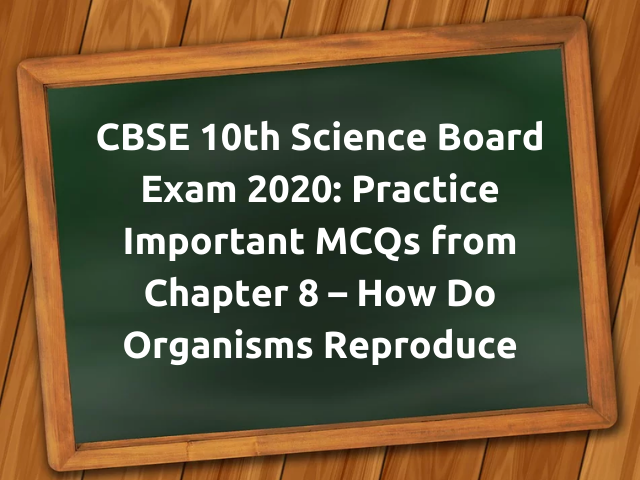MCQ Questions for Class 10 Science How Do Organisms Reproduce with Answers: Students CBSE Board Exams 2020 Time Table is out now. The board is going to conduct a Class 10 CBSE Science Exam on 4th March 2020. As per their official notification, this time CBSE Exam Pattern 2020 is having slight changes. The board decided to add MCQ Questions for Class 10 CBSE Board Exams. Here, you will find important MCQs from CBSE Class 10 Science Chapter 8 How Do Organisms Reproduce along with the answers.
CBSE Class 10 Science MCQs of How Do Organisms Reproduce with Answers
Such Multiple Choice Type Questions are ideal to brushes your basic concepts to answer in CBSE Class 10 Science Exam 2020. Also, this objective type questions will help you to adjust with all various approaches. In this article, we have provided How Do Organisms Reproduce MCQ Questions for Class 10 CBSE Science Exam 2020 with a detailed explanation of answers. It makes easy to grasp the in-depth concept and logic of the question. So, practice below provided MCQ’s of CBSE Class 10 Chapter 8 How Do Organisms Reproduce topics to score maximum marks in your pre-board and final board exams.
Question 1. During favourable conditions, Amoeba reproduces by
(a) multiple fission
(b) binary fission
(c) budding
(d) fragmentation
Answer
Answer: b
Question 2. A feature of reproduction that is common to Amoeba, Yeast and Spirogyra is that
(a) they reproduce asexually
(b) they are all unicellular
(c) they reproduce only sexually
(d) they are all multicellular
Answer
Answer: a
Question 3. The ability of a cell to divide into several cells during reproduction in Plasmodium is called
(a) budding
(b) multiple fission
(c) binary fission
(d) reduction division
Answer
Answer: b
Question 4. Bryophyllum can be propagated vegetatively by the
(a) stem
(b) leaf
(c) root
(d) flower
Answer
Answer: b
Question 5. Vegetative propagation refers to formation of new plants from
(a) stem, flowers and fruits
(b) stem, leaves and flowers
(c) stem, roots and flowers
(d) stem, roots and leaves
Answer
Answer: d
Question 6. In a potato, vegetative propagation takes place by:
(a) root
(b) leaf
(c) stem tuber
(d) grafting
Answer
Answer: c
Question 7. Vegetatively propagated plants
(a) do not bear roots
(b) do not bear buds
(c) are genetically similar
(d) are genetically dissimilar
Answer
Answer: c
Question 8. Spirogyra reproduce by
(a) budding
(b) fragmentation
(c) regeneration
(d) fission
Answer
Answer: b
Question 9. In Rhizopus, tubular thread like structures bearing sporangia at their tips are called
(a) filaments
(b) hyphae
(c) rhizoids
(d) roots
Answer
Answer: b
Question 10. Plants like banana, rose, jasmine, orange have lost the capacity to produce
(a) seeds
(b) buds
(c) flower
(d) roots
Answer
Answer: a
Question 11. The flower of the Hibiscus plant is
(a) bisexual
(b) unisexual
(c) neuter
(d) very small
Answer
Answer: a
Question 12. The part of the flower which is present in the centre of the flower is
(a) Sepals
(b) Petals
(c) Carpels
(d) Stamens
Answer
Answer: c
Question 13. The seed that contains the future plant is called the
(a) cotyledons
(b) seed coat
(c) germ cells
(d) embryo
Answer
Answer: d
Question 14. The period of pregnancy is called
(a) gestation period
(b) incubation period
(c) ovulation
(d) menstruation period
Answer
Answer: a
Question 15. The process of release of eggs from the ovary is called
(a) menstruation
(b) reproduction
(c) insemination
(d) ovulation
Answer
Answer: d
Question 16. The period during adolescence when the reproductive tissues begin to mature is called
(a) ovyfetion
(b) puberty
(c) germination
(d) propagation
Answer
Answer: b
Question 17. In human beings, the fertilization occurs in the
(a) uterus
(b) ovaries
(c) fallopian tubes
(d) vagina
Answer
Answer: c
Question 18. Along the path of the vas-deferens the secretions of which gland provide nutrition to the sperms?
(a) Prostate glands
(b) Seminal vesicles
(c) Scrotum
(d) Urinary bladder
Answer
Answer: b
Question 19. The embryo in humans gets nutrition from the mother’s blood with the help of a special tissue called
(a) Placenta
(b) Villi
(c) Uterus
(d) Womb
Answer
Answer: a
Question 20. Which among the following diseases is not sexually transmitted?
(a) Syphyllis
(b) Hepatitis
(c) HIV-AIDS
(d) Gonorrhea
Answer
Answer: b
Question 21. Which of the following method of contraception protects from acquiring sexually trans¬mitted diseases?
(a) Surgery
(b) Condoms
(c) Copper-T
(d) Oral-pills
Answer
Answer: b
Question 22. In human males, the testes lie in the scrotum, because it helps in the
(a) process of mating
(b) formation of sperms
(c) easy transfer of gametes
(d) secretion of estrogen
Answer
Answer: b
Fill in the Blanks
1. The process of reproduction involving only one cell or one parent is called ………….. .
2. ………….. is a duct coming from the urinary bladder which carries sperms.
3. Process of fertilization takes place in the ………….. tube in humans.
4. ………….. is the ability of an organism to replace its lost body parts.
5. ………….. is called the production of new plants from stems, roots or leaves.
6. ………….. is the term used to refer to the commencement of menstruation at puberty.
7. ………….. is the virus that causes AIDS.
Answers
1. Uniparental/ Asexual reproduction
2. Vas deferens
3. fallopian
4. Regeneration
5. Vegetative propagation
6. Menarch
7. HIV-Human Immuno Virus
you can practice more MCQ Questions for Class 10 Science How Do Organisms Reproduce with Answers from here.
We hope the given MCQ Questions for Class 10 Science How Do Organisms Reproduce with Answers PDF will help you. If you have any query regarding CBSE Class 10 Science Chapter 8 How Do Organisms Reproduce Multiple Choice Questions with Answers, drop a comment below and we will get back to you at the earliest.
